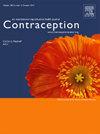Impact of progestin type on the risk of drug interactions between combined oral contraceptives and psychotropic drugs: A pooled analysis of real-world data
IF 2.3
2区 医学
Q1 OBSTETRICS & GYNECOLOGY
引用次数: 0
Abstract
Objectives
To assess the risk of contraceptive failure and adverse events (AEs) associated with the type of progestin when coadministered with psychotropic drugs within a routine clinical practice setting.
Study design
A pooled analysis of four large, prospective, multinational cohort studies including women with a new prescription of combined oral contraceptives (COCs) and concomitant psychotropic drug use from 13 European countries and the United States. We determined the frequency of contraceptive failures and AEs within 6 months after COC initiation by progestin type. Furthermore, we calculated crude and propensity score weighted incidence rate ratios with corresponding 95% confidence intervals via Poisson regression. Covariates used for propensity score estimation included age, body mass index, smoking, medical history, history of hormonal contraceptive use, and education level.
Results
Our analysis comprised 7679 COC users reporting psychotropic drug use at baseline. The most common progestin type was drospirenone (30.0%) followed by norethisterone acetate/norethindrone acetate (20.5%), levonorgestrel (17.3%), norgestimate (11.6%), norethindrone (5.7%), nomegestrol/nomegestrol acetate (5.6%), desogestrel (4.9%), and dienogest (4.4%). Overall, 39 (0.5%) contraceptive failures and 156 (2.0%) AEs occurred within the first 6 months of follow-up. Head-to-head comparison of different progestins against levonorgestrel regarding AEs showed a significantly lower risk for drospirenone (weighted incidence rate ratio 0.5, 95% confidence interval [0.3–0.9]), while no difference was observed for other progestins.
Conclusions
Among women using psychotropic drugs, drospirenone was associated with a lower risk of AEs compared to levonorgestrel, while other progestins showed no significant differences. The number of contraceptive failures was low across progestins.
Implications
Compared to levonorgestrel, drospirenone has shown a reduced risk of adverse events when coadministered with psychotropic drugs, whereas other common progestins showed no significant differences. Contraceptive failures were rare across progestins. This analysis provides valuable real-world data on potential drug interactions and may be used for future updates of evidence-based guidelines on contraception.
黄体酮类型对联合口服避孕药和精神药物之间药物相互作用风险的影响:对真实世界数据的汇总分析。
目的:评估在常规临床实践中与精神药物联合使用黄体酮时避孕失败和不良事件(ae)相关的风险。研究设计:对四项大型、前瞻性、多国队列研究进行汇总分析,研究对象包括来自13个欧洲国家和美国的新处方联合口服避孕药(COCs)和同时使用精神药物的妇女。我们按黄体酮类型测定COC启动后6个月内避孕失败和ae的频率。此外,我们通过泊松回归计算了粗糙和倾向评分加权发病率比(IRR)和相应的95%置信区间(CI)。用于倾向评分估计的协变量包括年龄、体重指数、吸烟、病史、激素避孕药使用史和教育水平。结果:我们的分析包括7679名COC使用者在基线报告精神药物使用情况。最常见的黄体酮类型是屈螺酮(30.0%),其次是醋酸去甲睾酮/醋酸去甲炔雌酮(20.5%)、左炔诺孕酮(17.3%)、诺格估计(11.6%)、去甲炔雌酮(5.7%)、炔诺孕酮/醋酸去甲炔雌酮(5.6%)、地诺孕酮(4.9%)和地诺孕酮(4.4%)。总体而言,39例(0.5%)避孕失败和156例(2.0%)不良反应发生在随访的前6个月内。不同孕激素与左炔诺孕酮在ae方面的正面比较显示,屈螺酮的风险显著降低(加权IRR为0.5,95% CI[0.3-0.9]),而其他孕激素没有差异。结论:在使用精神药物的女性中,与左炔诺孕酮相比,屈螺酮与ae的风险较低,而其他孕激素无显著差异。不同孕激素组的避孕失败率较低。
本文章由计算机程序翻译,如有差异,请以英文原文为准。
求助全文
约1分钟内获得全文
求助全文
来源期刊

Contraception
医学-妇产科学
CiteScore
4.70
自引率
17.20%
发文量
211
审稿时长
69 days
期刊介绍:
Contraception has an open access mirror journal Contraception: X, sharing the same aims and scope, editorial team, submission system and rigorous peer review.
The journal Contraception wishes to advance reproductive health through the rapid publication of the best and most interesting new scholarship regarding contraception and related fields such as abortion. The journal welcomes manuscripts from investigators working in the laboratory, clinical and social sciences, as well as public health and health professions education.
 求助内容:
求助内容: 应助结果提醒方式:
应助结果提醒方式:


